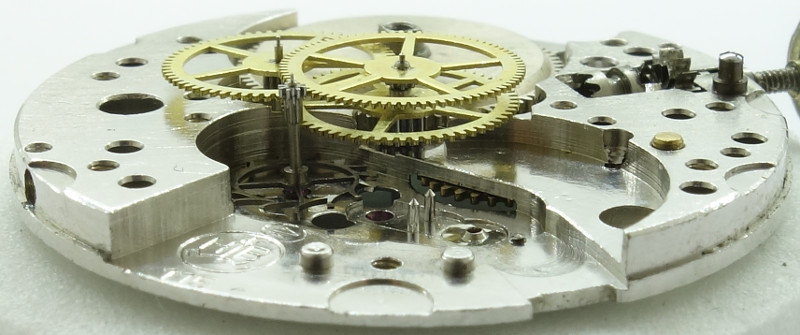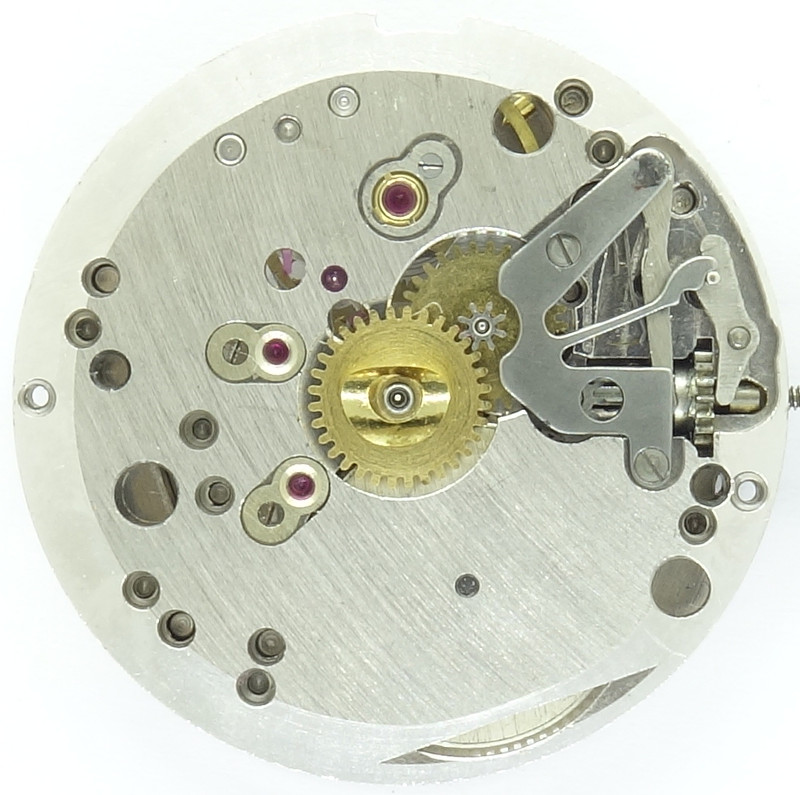Description
In the early 1950ies, the 11 1/2 ligne windup movement HB 115 was launched. Neither at first glance nor at deeper inspection, a difference to its direct relative, the HB 115 MS, could be determined.
The exemplary marked base plate already shows, that the HB 115 is a movement of good quality.
All important bearings, including those of the minute wheel, contain bearing jewels, and the space, which the large base plate with a diameter of 25.6mm offers, is perfectly uses for a very large mainspring barrel and a very large screw balance.
Both are requirements for a highest possible accurancy.
As usual in that era, the HB 115 uses a directly driven center minute wheel, which is beared under its own bridge.
The gear train is also a contemporary construction: The large mainspring barrel directly drives the center minute wheel, followed by third wheel, directly driven center seconds wheel and finally the steel escape wheel.
Although the third wheel is beared on the base plate, its sprocket is above the minute wheel bridge. The pinion however engages with the center minute wheel, which is locate below the minute wheel bridge.
As escapement, a swiss pallet lever escapement is used. It works with a monometallic screw balance, which is beared in two Super-Shock-Resist bearings and protected against shocks.
The HB 115 works with contemporarily slow 18000 A/h, which can be adjusted with a long regulator arm on top of the balance cock.
It’s a bit odd, that the HB 115 has got zero cap jewels on the movement side, but two cap jewels on the dial side, one for the escape wheel and one for the third wheel. By this means, the unusual number of eighteen jewels was achieved.
The keyless works uses a yoke winding system with a setting lever spring, which is partially recangularily shaped and so can be distinguished easily from other setting lever springs.
In the lab
Timegrapher result
After the simple revision without spare parts, the daily rates were within the expectations of a 60 year old windup movement, which was extensively used. Only the runaway in position “dial up” is remarkable and might be caused by the non professional cleaning and oiling attempts (or lack of them) of the balance wheel bearings".| horizontal positions | |||
|---|---|---|---|
| dial up | -194 s/d | 128° | 1.1ms |
| dial down | +52 s/d | 224° | 1.1ms |
| vertical positions | |||
| crown right (12 up) | -18 s/d | 234° | 2.4ms |
| crown up (3 up) | -69 s/d | 177° | 2.5ms |
| crown left (6 up) | -14 s/d | 175° | 1.0ms |
| crown down (9 up) | -52 s/d | 156° | 1.0ms |
Technical data
| Manufacturer: | HB |
| Caliber: | 115 |
| Size: | 11 1/2''' (measured: 25,6mm) |
| A/h: | 18000 |
| Number of jewels: | 18 |
| Escapement: | Pallet lever |
| Balance types: |
Nickel screw balance |
| Shock protection(s): |
Super Shock Resist |
| Balance bearing / direction hairspring: | Clockwise |
| Moveable stud: | no |
| Adjust mechanism: | Long regulator arm |
| Construction: |
|
| Construction type: | solid construction |
| Winding mechanism: | yoke winding system |
| Setting lever spring: | 2 hole(s) |
| Features: |
|
| References: |
Flume: 1952 9 |
| Mentioning in literature (years): | 1951 - 1960 |
| Inventory number: | 19026 |







